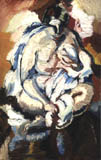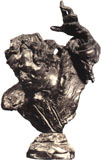|
|
|
|
|
|||||||
|
|
|||||||
|
|
|||||||
|
Exhibit of the works of Alexander Archipenko "Preserved in Ukraine". NAMU. 04.12.2001-02.01.2002, Kiev.
Organized by: Prof. Dmytro Horbachov , Iryna Horbachova (Deputy Director, NAMU, Kiev).
An exhibit of the works of Kyivite Alexander Archipenko, an artists of almost planetary significance, is at last taking place in his hometown. In the 20th cent. Ukraine gave birth to artists who were pacesetters-originators of artistic trends which they dictated to the world and which the world accepted.
In the past, some Ukrainian
artists had international authority; Alimpiy Pecherskyi (11 th cent.),
Andriy Rusyn, a court painter of the Polish King Jagiello (15th cent.),
Dmytro Levytskyi, Volodymyr Borovykovskyi, Illya Repin - court painters of
various Russian Emperors. But their effect was only local.
Alexander Archipenko was part of
this group. The first cubist in sculpture, one could say, like Picasso in
sculpture, he became the unquestionable authority for Henry Moore,
Giacometti,
Countries where Archipenko lived
and taught - France, Germany, the United States pride themselves of his
presence in their cultural environment, and their most outstanding museums
have acquired Archipenko's works for their collections: Centre Pompidou in
Paris, the Guggenheim and the Modern Art Museum in New York as well as
museums of Stockholm, Tel-Aviv and Moscow, to name a few.
His personal exhibits during his
life and after - number a few hundred. The sculpture "Shevchenko - the Prophet" is also in the Museum's collection. Not long ago it was donated by the Parisian collectioner Arystyd Virsta. The exhibited drawings were at one time presented by Archipenko himself to the National Museum in Lviv. Fortunately they survived to this day in contrast to two paintings and one sculpture destroyed by Stalinist barbarians in 1952, which Archipenko had also donated to the Lviv Museum. They survived due to the ingenuity of museum workers in the midst of a purge by a "State Commission on Art" avidly destroying works of "formalists," "nationalists", "emigrants" (which included Archipenko). The museum workers simply labeled the drawings on exhibit today as "unknown artist." The American period of the artist is represented by a small painting of the "Nude",powerful in its expressive content. The paintings reveal the hand of the sculptor - whose manner was described in the West as both "tender and stern". And, finally, two absolutely unknown works dated 1906 - from a private collection represent the artist's Kyiv period - which is known to us only from archives. "Landscape" painted at a time when he studied with the Kyiv artist S. Svitoslavskyi and pastel "Nude" which despite its student character previews some characteristcs of the future mature Archipenko. The exhibit "Preserved in Ukraine" should be viewed as a promise of an all-encompassing exposition of the works of the Great Master in his Motherland, which might bear the title of "Preserved in the Whole World". Iryna Horbachova |
|||||||
|
Works of Alexander Archipenko on the exhibit: |
|||||||
|
Act. 1906. Pastel on board. 65 by 45 cm. Private collection. Details... |

Nude. 1926. Oil on board. 28,3 by 18 cm. Private collection, Ukraine. Detailed... |

|
|||||
|
|
|
|